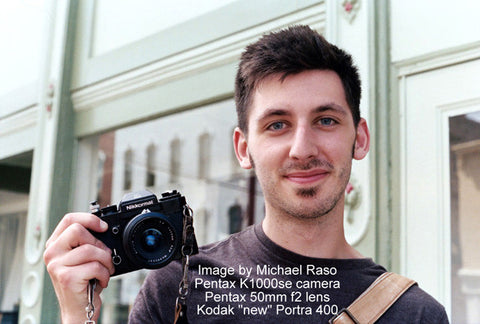
Let’s start with something simple and move up to more challenging metering situations. You can actually end up with quite a bit of saturation on Portra if exposed this way, but be careful as shadows can get muddy and oddly oversaturated. If you want to use the film and still retain more saturation, I would recommend not adding the additional two-thirds stop as I do and then also using GND filters to control the sky. In most of these images you can see that there is still plenty of detail and color in the highlights, but that colors in the brightest parts of the image are certainly on the soft side which is a desired look that I’m wanting to achieve.
PORTRA 400 35MM FULL
This means that the film is almost always being overexposed by more than a full stop, and skies might be overexposed by a stop or two (or sometimes several) more than that.

I pay more attention to the average reading in the foreground rather than the entire scene including the sky and I often have exposure compensation on my metering camera set to +0.7 for an extra two-thirds stop.

All of the info in this article refers to the metering, with no adjustments to developing.Īside from just metering Portra 160 at 100, I also err on the side of overexposure. The answer is no, you just do a standard development.
PORTRA 400 35MM ISO
People often ask me if they need to develop the film differently when shooting Portra 160 at ISO 100, etc. I generally end up overexposing a little bit less when using it on medium format because I want to retain a bit more of the color saturation of the film for the landscape shots. When I use Portra in medium format I almost always go with the 400 version as my goal is more of a general all-purpose landscape film and since I’m using a smaller camera it’s nice to have the option of hand holding it every now and then. On large format I only use the 160 version because I’m going for ultimate quality and lower grain along with a specific look. Yes, I notice that these are not the same exposure difference for the two different versions but that’s mostly because I use the two stocks with different goals in mind. For that reason I meter the 160 version at ISO 100 and the 400 version at ISO 320. This film loves overexposure and seems to know no limits in this regard. By no means do you have to do it this way, you can use a dedicated light meter or even a metering app on your phone to get the perfect shots on Portra. I’m a huge fan of average metering and use a small mirrorless camera as a light meter and exposure preview. It might also be a good idea to read my article on metering to get a general grasp of how I work. Let’s go through some images in a variety of lighting conditions and I’ll show you how I metered for them. Sunset, golden hour, twilight, and even midday light all have a special charm on this film. The more I use the film the more it becomes clear how versatile it really is. Generally speaking Portra is all about the subtleties, but that doesn’t mean it’s a one-trick-pony.

Countless people have messaged me saying that they’ve tried Portra themselves and just weren’t happy with the results, so I think with a few quick tips we can demystify this magical film and unlock its true potential. This film can have such a unique color palette that is flattering for many types of subjects and light conditions, but it’s also one of the films that I’ve gotten the most questions about when it comes to metering and shooting. If you’ve been keeping an eye on my recent work you’ve probably noticed that I’ve got a passion for Portra.


 0 kommentar(er)
0 kommentar(er)
